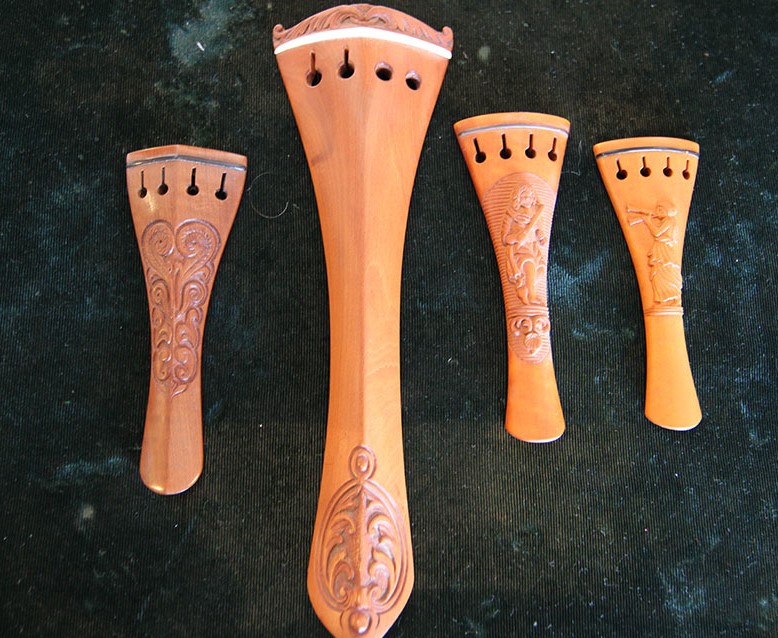Tailpiece Choices That Shape Your Violin’s Tone

The Subtle Power of the Violin Tailpiece
When discussing what shapes the rich, nuanced sound of a violin, many musicians immediately mention the type of strings, the quality of the bow, or the craftsmanship of the instrument itself. However, there’s one small but vital component that often flies under the radar: the tailpiece. Though it may appear to be a simple connector that anchors the strings, the tailpiece plays a powerful role in tone production and responsiveness.
Located at the base of the violin, the tailpiece holds the strings in place and influences the length of the string between the bridge and the fine tuners or endpin. This length, known as the afterlength, contributes significantly to how the violin resonates and projects sound. A well-chosen tailpiece can brighten a dull tone, soften a harsh edge, or enhance clarity and projection. On the other hand, a poorly matched or improperly installed tailpiece can compromise your violin’s sonic potential, no matter how high-quality the other components may be.
In this article, we explore how different materials, shapes, and designs of the tailpiece can dramatically influence the sound of your instrument. Whether you’re a beginner seeking more resonance or a professional chasing tonal perfection, understanding the impact of your tailpiece choice is essential.
Materials Matter: Wood, Carbon, and Metal
One of the most critical aspects affecting your violin’s tone is the material of the tailpiece. Traditional wooden tailpieces—usually made from ebony, boxwood, or rosewood—are known for their warm, organic resonance. Ebony tends to offer a balanced tone with slightly enhanced lows, while rosewood can produce a sweeter, more mellow sound.
Modern options include carbon fiber and metal tailpieces, which bring their own tonal characteristics. Carbon fiber is especially popular among contemporary players for its lightweight structure and added brilliance. It increases projection and may be ideal for soloists who need their sound to cut through an ensemble. Metal tailpieces, though less common for classical playing, can create a sharper, brighter sound, often preferred in electric or crossover instruments.
The choice of tailpiece material should complement your instrument’s natural tendencies. For instance, if your violin already sounds bright, a rosewood tailpiece might help mellow it out. Conversely, a carbon fiber tailpiece can breathe new life into a dark or overly muted instrument.
Shape and Design: More Than Aesthetics
Beyond material, the shape and design of the tailpiece also influence your violin’s performance. Some tailpieces are designed with integrated fine tuners, while others use external tuners. Though integrated fine tuners offer convenience, they add weight and may dampen resonance.
The afterlength—the distance between the bridge and tailpiece—is affected by the size and positioning of the tailpiece. A properly adjusted after length (typically 1/6 the length of the vibrating string) promotes sympathetic resonance, improving tonal richness and overtones. Too short or too long an afterlength can cause tuning issues, wolf tones, or diminished projection.
Some players also experiment with tailpiece shape: French-style, Hill-style, and even custom models with curved or tapered designs. These may impact tension distribution across the bridge and ultimately influence the feel and sound of the violin.
Installation and Adjustment: The Luthier’s Touch
Even the best tailpiece won’t yield results if it’s not properly installed. The tailgut (the wire or synthetic cord that secures the tailpiece to the endpin) must be adjusted to the right length and tension. Too tight, and it chokes the instrument; too loose, and it compromises stability.
Consulting a skilled luthier for tailpiece selection and installation is highly recommended. They can help measure the correct afterlength, choose complementary materials, and ensure the tailpiece enhances rather than hinders your violin’s performance.
Conclusion: Small Change, Big Difference
While it may seem like a minor component, the tailpiece is a powerful tool for refining your violin’s tone, response, and playability. From selecting the right material to ensuring precise installation, every detail matters. If you’re looking to improve your sound without investing in a new instrument, changing your tailpiece might be the secret weapon you’ve overlooked. Whether you seek warmth, clarity, or volume, let your tailpiece work in harmony with the rest of your instrument to unlock your violin’s full potential.
Enhance Your Violin’s Tone with Kinglar’s Expert Tailpieces
At Kinglar Violin, we understand how the right tailpiece can dramatically transform your sound. Whether you’re a student seeking better resonance or a professional fine-tuning your tone, our expertly crafted tailpieces—available in ebony, rosewood, boxwood, and carbon fiber—are precision-designed to elevate your playing.
💬 Need Help Choosing the Right Tailpiece?
Our specialists are ready to guide you through every detail, from materials to afterlength adjustments.
📍 Visit us:
KINGLAR
155/1, Main Road East
New Barrackpore, West Bengal, India
📞 Call us at: +91-9051144332
🌐 www.kinglarviolin.com
📧 Email: kinglarviolin@hotmail.com

Leave a Reply